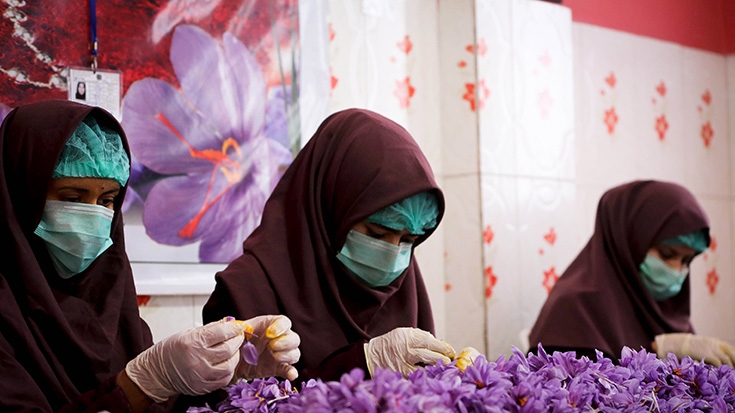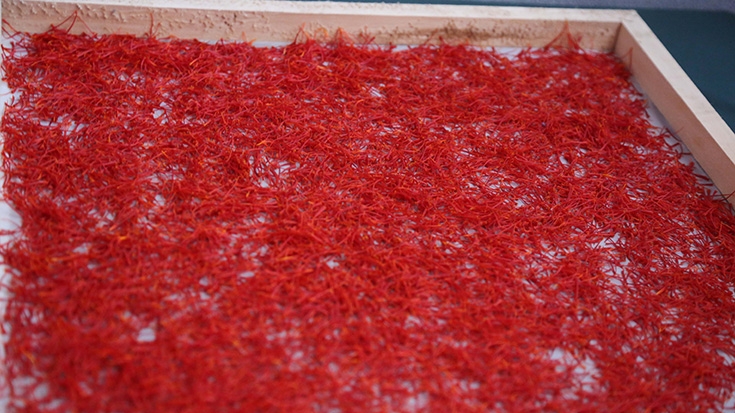Consumers use saffron for medicine, in foodstuff and cooking, and as a remedy for many ailments. Currently, the price of a kilogram of Afghanistan’s saffron in the global markets is around $2,000. “Saffron can be cultivated in many areas. Economically, if each family had half a jerib or one jerib (half an acre) of land for saffron, we would be saved from poverty”, says Bashir Ahmad Rashidi, head of NUSG and also head of Aryana Saffron Company. His company, started in 2011, is now considered one of the premiere companies in saffron production.
Saffron production in Afghanistan dates back to more than 100 years. But saffron cultivation was forgotten until some 22 years ago when some Afghans who had been acquainted with saffron cultivation and production in Iran returned and decided to continue the practice in Ghoryan district in Herat Province. This trend, which started with 60 square meters of land, moved so fast that now more than 800 hectares of land in Herat are under saffron cultivation.
The lucrative harvest of saffron drew the government’s attention, giving rise to the idea that saffron can become a good source of income for rural inhabitants. Thus, the Ministry of Agriculture, Livestock and Irrigation (MAIL) imported 18 tons of saffron from Iran and the pilot cultivation phase started. Four years later, it was clear that the result was better than expected.
Increasing saffron production, decreasing poppy cultivation
The Government of Afghanistan and international community have been trying for some years to increase saffron production as well as raise awareness of its benefits. This is aimed at discouraging farmers from poppy cultivation and reducing poppy in the country. According to the United Nations Office for Drug and Crime, Afghanistan is among the top poppy producers in the world.
Initiatives, such as the Afghanistan Rural Enterprise Development Program (AREDP) that operates within the framework of the Ministry of Rural Rehabilitation and Development (MRRD) and supported by the World Bank and Afghanistan Reconstruction Trust Fund (ARTF), are geared towards expansion of Afghanistan’s licit industries in order to reduce poppy cultivation.
Started in 2010, AREDP aims to enhance economic mobilization and activities by organizing the rural poor into Savings Groups, Village Savings and Loan Associations, and Enterprise Groups. It works towards strengthening market linkages and value chains for rural enterprises by providing technical support to over 1,345 Enterprise Groups (63 percent female) and 256 Small Medium Enterprises (13 percent female) that have been selected for their potential as key drivers of rural employment and income generation.
Among other tasks, this program regularly convenes exhibitions and gatherings about cultivation, production, and selling of saffron so that farmers are better educated on the saffron cultivation process. It also enables farmers to travel so that they could learn from the experiences of other countries.
“We have provided five national exhibitions for 10 saffron enterprises,” says Rahmatullah Quraishi, Executive Director, AREDP. The AREDP have also supported exposure visits to India for about six saffron enterprises of Herat province to enhance their knowledge, technical skills, and market linkages about saffron. The trip cost almost $20,000 to $30,000, Quraishi points out, adding that such trips have proved to be very instrumental in improving saffron production, market linkages, enhancement of skills and knowledge in Herat. Following this exposure visit and technical support from AREDP, there has been an increase of around 90 percent in sales and 20 percent in employment in these enterprises.
Although saffron production has been off to a good start, saffron producers are hoping to see an increase in demand in foreign and domestic markets. “We have very few contracts through which the farmers can officially export saffron, but it is individually exported to India, Dubai, and Turkey,” says Bashir Ahmad Rashidi. He expects that saffron production in Herat will rise to 4 tons in 2014 and would like to see more attention paid to supplying saffron to domestic markets. “Using saffron has increased in Afghanistan, but has not become part of the culture yet,” he observes.
More jobs for women
Cultivation and production of saffron creates numerous job opportunities, especially for women who perform 80 percent of the activities including harvesting, refining, and packaging.
Beheshta Karimi, a young woman in her twenties, works for Aryana Saffron Company. She is responsible for refining and packaging the produce. In this capacity, she oversees around 10 other women and works alongside them in a small room. Desks are arrayed in the corners of the room and the women calmly carry out their activities behind these desks.
“We start at 8 in the morning and by 5 in the afternoon, we must prepare one kilogram of saffron ready for packaging,” says Beheshta. She receives a salary of Afghani 7,000 (about $120) and her subordinates receive Afghani 5,000 (about $87) per month. She does not consider her work difficult and says that her colleagues are extremely happy to have this job opportunity.


